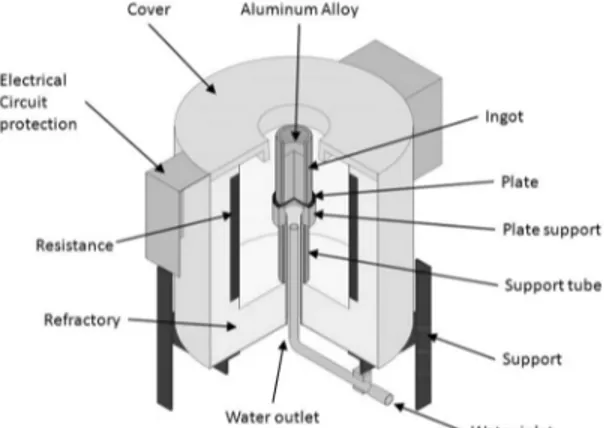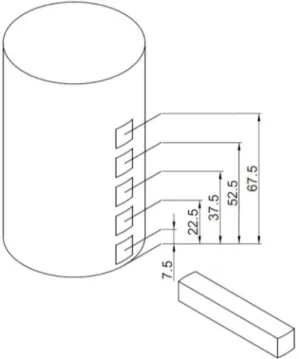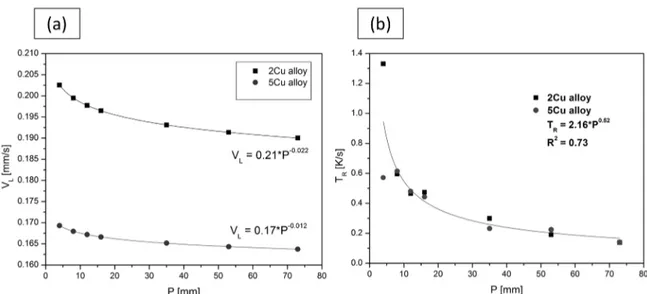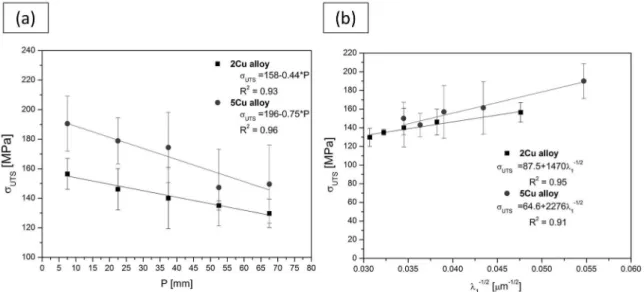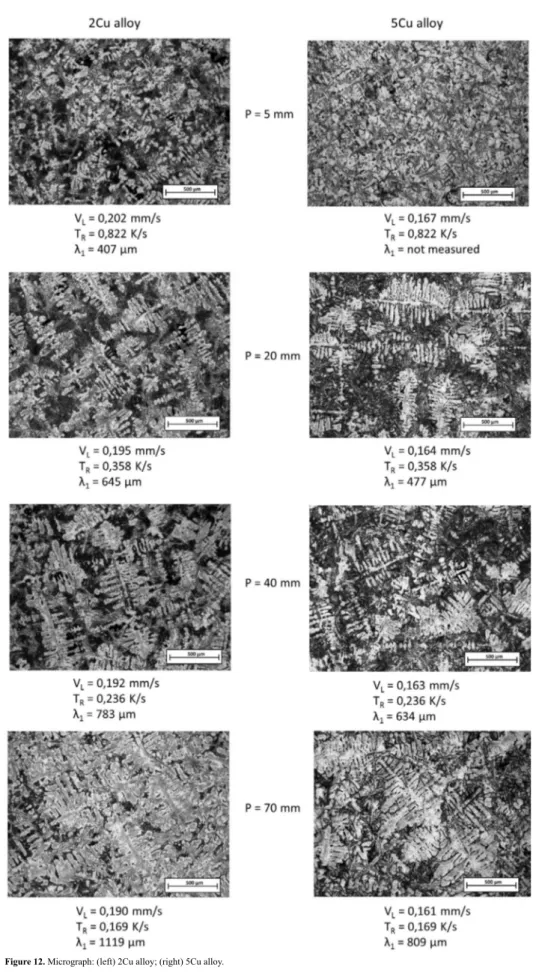An Experimental Study of the Solidification Thermal Parameters Influence upon
Microstructure and Mechanical Properties of Al-Si-Cu Alloys
Mauricio Silva Nascimentoa* , Antônio Tadeu Rogério Francoa, Carlos Frajucaa, Francisco Yastami
Nakamotoa, Givanildo Alves dos Santosa, Antônio Augusto Coutob,c
Received: September 26, 2017; Revised: May 05, 2018; Accepted: May 16, 2018
Metals solidification involves the transformation of the molten metal back into the solid state. Solidification structures impact heavily on the final product's characteristics. The microstructure effects on metallic alloys properties have been highlighted in various studies and particularly the dendrite arm spacing influence upon the mechanical properties such as tensile strength has been reported. In the present investigation, Al-10wt%Si-2wt%Cu and Al-10wt%Si-5wt%Cu alloys were directionally solidified upward under transient heat flow conditions. The experimental results include solidification thermal parameters such as tip growth rate and cooling rate, optical microscopy, volume fraction of the eutectic mixture, primary dendritic arm spacing and ultimate tensile strength. Experimental growth laws of primary dendrite arm spacing as a function of the solidification thermal parameters are proposed. The Hall-Petch mathematical expressions were used to correlate the ultimate tensile strength as a function of the primary dendritic arm spacing. It was found that the alloy with higher copper content had a more refined structure. More refined structures had higher ultimate tensile strength values.
Keywords: solidification, microstructure, primary dendrite arm spacing, mechanical properties, Al-Si-Cu alloy.
* e-mail: mauricio.nascimento@ifsp.edu.br
1. Introduction
The liquid transformation into a solid is probably the most important phase transformation in applications of science and engineering materials1,2. Currently a large part of the concepts
and methods developed in support of solidification research, which is the main phenomenon that occurs during casting, can be applied on an industrial scale, allowing a visible improvement in the manufactured parts quality, making solidification studies a powerful tool for its economic potential3. The microstructure
effects on metallic alloys properties has been highlighted in various studies and particularly, the grain size influence and dendrite arm spacing upon the mechanical properties has been reported1,4. There
are a lack of studies about multicomponent alloys solidification in transitional arrangements on specific literature5. The ternary
system (Aluminum, Silicon and Copper) has excellent properties as mechanical strength, low density as compared to ferrous alloys and good flowability. These properties make the system a good choice on automotive and aerospace industry, calling researchers attention3,6. Costa et al7 investigated the influence
of silicon on the microstructure comparing directional upward and horizontal solidification for the alloys Al-6wt%Cu-4wt%Si and Al-6wt%Cu, demonstrating that silicon alloying contributes to significant refinement of primary/secondary dendrite arm spacings. Araujo et al8 investigated the interrelation between
the secondary dendrite arm spacing and microhardness for
Al-3wt%Cu, Al-3wt%Si and al-3wt%Cu-5.5wt%Si alloys in horizontal directional solidification. Vasconcelos et al9 investigated
the interconnection between microstructure and microhardness of horizontal directional solidification for Al-6wt%Cu-8wt%Si alloys. In addition to the primary dendritic arm spacing, the morphology of the eutectic mixture influences the mechanical properties. Yildirim et al10 found that the addition of niobium
to an iron aluminides modifies the eutectic mixture, so that the alloys exhibited higher compressive strength. After the heat-treated, alloys exhibited ultra-high compressive strength and highly enhanced compressive fracture strain. There were no significant changes in the volumetric fractions of the phases and in the primary dendritic arm spacing after the heat treatment, being the change of the mechanical properties related to the morphology of the eutectic mixture.
In the present investigation, Al-10wt%Si-2wt%Cu (cited as 2Cu alloy) and Al-10wt%Si-5wt%Cu (cited as 5Cu alloy) alloys were directionally solidified upward under transient heat flow conditions. The experimental results include tip growth rate (VL) and cooling rate (TR), primary dendritic arm
spacing (PDAS) and ultimate tensile strength (σUTS). These alloys were chosen so that only the Cu content was different, in order to analyze their influence. Controlling the thermic solidification parameters such as VL and TR, it is possible
to predict the conditions to obtain the microstructures with the desired properties11,12,13.
aInstituto Federal de Educação, Ciência e Tecnologia de São Paulo - IFSP, São Paulo, SP, Brasil bInstituto de Pesquisas Energéticas e Nucleares - IPEN, São Paulo, SP, Brasil
2. Experimental Procedure
The experimental apparatus consists of a solidification furnace in cylindrical form (figure 1), with external steel casing and refractory bricks. Inside the oven there are an electrical resistors connected to a control panel and two support tubes. The inner one being made of stainless steel AISI 304 and the outer steel SAE 1020. Between these tubes there is a layer of refractory cement. An inner tube is responsible for directing the water jet to the inner surface of the plate, made of SAE 1020 steel. The thickness of the plate in the heat exchange region is 5 mm thick. In the upper surface, where the ingot is positioned, it was sanded with 1200 mesh sandpaper. The ingot was manufactured in stainless steel AISI 304 with internal diameter of 60 mm, external diameter of 76 mm and height of 160 mm. Type K thermocouples were positioned at distances, relative to the plate, of 4, 8, 12, 16, 35, 53 and 73 millimeters.
Figure 1. Schematic illustration of the upward unidirectional solidification furnace
The alloys were prepared in a graphite-clay crucible in a muffle-type electric furnace using commercially pure metals, which were analyzed by the X-ray spectrometry technique using a Spectro Spectromaxx Spectrometer (Table 1). Four casting leaks were performed for each of the alloys, all of them with a casting temperature of 700 ºC. The first ingot was used to analyze the solidification kinetics and preparation for micrographic analysis and the other three ingots were
Table 1. Chemical composition of the raw materials in weight %
Materials Al Si Ca Fe Ti Cu Mg Zn NI Cl Other
Aluminum 99.8 0.071 0.095 0.001 0.033
Silicon 1.56 96.4 0.486 0.430 0.110 0.378 0.199 0.437
Copper 1.16 0.139 0.143 97.4 0.288 0.207 0.164 0.499
Table 2. Chemical composition of ingots in weight %
Alloy Si Cu Fe Other Al
Al-10wt%Si-2wt%Cu 9.99 1.90 0.22 0.09 87.78
Al-10wt%Si-5wt%Cu 10.26 5.25 0.21 0.08 84.20
used to make test specimens for tensile tests. For each leak a sample was taken to check the composition of the prepared alloy. The analysis was performed by the X-ray spectrometry technique using a Bruker S2 Ranger Spectrometer (Table 2). After the pouring, the cooling started when the water jet was turned on at a flow rate of 21.6 L/min. All thermocouples were connected to a NI 9212 data acquisition module set and NI cDAQ 9171 chassis from National Instruments, which sent the collected data via USB cable to a computer, thereby allowing the collection of temperature data as a function of time at a rate of one die per second (Figure 2).
Figure 2. Upward unidirectional solidification furnace with control panel, data acquisition unit connected to thermocouples and computer to present and store experimental data.
The function P=f(t) was experimentally defined by the intersection of the straight line equivalent to liquidus temperature (TL) of the alloy with the cooling curve of
each thermocouple. By means of this intersection of the line the time of passage of the liquidus isotherm in that position of each thermocouple is determined. The derivative of the function P=f(t) allowed to obtain the respective experimental values for the displacement velocities of the liquidus isotherm (VL), which corresponds to the liquid
front passage through each thermocouple. The cooling rate (TR) values for each position of the thermocouples
Transverse samples were taken from one of the solidified ingots for metallographic analysis at positions 5, 10, 20, 30, 40, 60 and 70 millimeters with respect to the cooling plate. These were embedded in bakelite, grinded and polished with diamond paste from 6 µm to 3 µm. The etchant used to reveal the microstructure was a 0.5% HF solution with a reaction time of approximately 22 seconds for the 2Cu alloy and 15 seconds for the 5Cu alloy. Optical microscopy was used to measure the PDAS for each selected position, and the triangle method was used14. At least 40 measurements
were performed for each position, being performed only in the columnar region as a way to correlate this macrostructure with the thermal variables and tensile strength (Figure 3). The volume fraction of the phases observed in the metallographic examinations was calculated based on the systematic manual point count procedure described in ASTM E562 standards.
Figure 3. Representative schematic of the technique used to quantify the PDAS in a cross section.
The test specimens were made from three ingots, providing the tensile test of three test specimens for each position defined in Figure 4. The lower face of the ingot is the one that was in contact with theheat exchange plate.
The specimens were prepared according to ASTM E 8M standards with a diameter of 5 mm and a gage length of 25 mm. The equipment used for the test was a Kratos universal testing machine which has its own software for storing and displaying data. Figure 5 shows the sense of request of the specimen in relation to the microstructure obtained.
3. Results and Discussion
The liquidus temperature for the alloys under study were obtained in the Al-10%Si-XCu pseudo-binary diagram generated in the Thermocalc software version 2017a and is shown in Figure 6. It is observed that there is a difference of approximately 10 ºC between the two compositions.
Figure 4. Location of test specimens for tensile testing (dimensions in millimeters).
Figure 5. Illustrative drawing of the specimen as a function of the microstructure, direction of growth and direction of application of the tensile test15.
Figure 7 shows the macrograph of an as-cast ingot evidencing the columnar structure obtained in the solidification. This structure is located from the heat exchange surface to a distance of 70 mm. In this position, for both alloys, there is a columnar/equiaxed transition (CET). Above this distance there is an equiaxed structure. This same procedure was performed for the other ingots, which were later cut for the preparation of the specimens.
The solidification thermal parameters obtained are shown in Figure 8. It can be seen that both VL and TR decreased
For TR, the experimental points of the two alloys were very
close (Figure 8 b). Thus, a single experimental equation was proposed for both alloys, evidencing that the percentage of Cu did not significantly change the TR.
It is shown in Figure 9 the correlation between PDAS (λ1)
and distance from heat extraction surface (P). It is possible to see that 5Cu alloy has lower λ1 values than 2Cu alloy,
showing an influence of the copper on the microstructure. For both alloys, higher position values (P) tends to increase the λ1 values.
Figure 6. Pseudo-binary phase diagram Al-10% Si-XCu.
Figure 7. Macrostructures evidencing the columnar/equiaxed transition (CET): 2Cu alloy (left) and 5Cu alloy (right)
Figure 8. Solidification Thermal Parameters: (a) Correlation between Tip growth rate (VL) and distance from heat extraction surface (P); (b) Correlation between cooling rate (TR) and distance from heat extraction surface (P).
Figure 9. Primary dendrite arm spacing (PDAS). Correlation between PDAS (λ1) value and heat-exchange surface (P).
The correlation among PDAS (λ1), tip growth rate (V
L) and cooling rate (TR) are shown in Figure 10. The
value of the exponent is set to adjust the equation that relates λ1 and TR was -0.55 proposed by Bouchard and
Kirkaldy15 for binary alloys. Several authors16,17,18,19 have
increasing TR values. It is also observed that, for the
5Cu alloy, the values of TR are lower than for the 2Cu
alloy. In Figure 10 b, λ1 values tend to decrease with
increasing VL values. The value of the exponent of the
equation relating λ1 and VL was different from -1,1
proposed by Bouchard and Kirkaldy15 for binary alloys.
Some authors20, 21,22 have also found different values of
exponent for VL in ternary alloys. It is also observed
that, for the 5Cu alloy, the values of VL are lower than
for the 2Cu alloy, demonstrating the influence of copper on the microstructure.
It is shown in Figure 11a, the correlation among ultimate tensile strength (σUTS) and the distance from heat-exchange surface. For higher position values the σUTS value tends to decrease. To correlate σUTS and λ1, the Hall-Petch equation
was used. The coefficients of the equations were defined by
Figure 10. Primary dendrite arm spacing (PDAS). (a) Correlation between PDAS (λ1) and cooling rate (TR); (b) Correlation between PDAS (λ1) and tip growth rate (VL ).
Figure 11. Ultimate tensile strength (σUTS). (a) Correlation between σUTS and surface distance; (b) Correlation between σUTS and PDAS (λ1).
the least squares method. Several authors19,23,24,25,26 used this
methodology. These authors also primarily use PDAS, not the secondary dendritic arm spacing (SDAS), in columnar structures. As in this work only the columnar structure was analyzed it was decided to use λ1. It is also possible to verify
that the higher the copper rate, the higher the values of σUTS. Figure 12 shows the transverse micrographs of the two alloys studied at positions 5, 20, 40 and 70 millimeters with respect to the heat extraction surface. It is observed that, for both alloys, the positions closest to the heat extraction surface have more refined structures. The 5Cu alloy presents lower λ1 values than the 2Cu alloy in all positions, evidencing the
The volumetric fraction of the eutectic mixture is presented in table 3. It is observed that the values of the volumetric fraction of the eutectic mixture decrease for larger distances of the surface of heat extraction, therefore for higher cooling rates, the greater the eutectic mixture fraction. This is in accordance with the literature27 because higher cooling rates
imply solidification out of balance, increasing the fraction of eutectic mixture.
Table 3. Volume fraction of the eutectic mixture
Position (mm) 2Cu Alloy 5Cu Alloy
5 0,590 0,509
20 0,598 0,552
40 0,552 0,576
70 0,473 0,473
4. Conclusions
In this experimental study on the influence of the solidification thermal parameters on the mechanical properties and microstructures of the 2Cu and 5Cu alloys, we can conclude:
1. The values of the solidification thermal parameters VL and TR decrease to positions furthest from
the heat exchange surface. The VL values are
higher for the 2Cu alloy, evidencing the influence of the lower copper content. The values of TR
were very close to the two alloys, evidencing that the copper content does not influence this parameter.
2. PDAS values tend to decrease as the distance from the heat exchange surface increases. The 5Cu alloy presents lower values of PDAS than the 2Cu alloy for all positions, evidencing that a higher copper content contributes to the refinement of the microstructure.
3. When PDAS is correlated with the solidification parameters VL and TR, it is observed that, for higher values of VL and TR, the values of PDAS tend to decrease. The 5Cu alloy presents lower values in this correlation than the 2Cu alloy evidencing the influence of the higher copper content.
4. When the σUTS is correlated with the PDAS, it is observed that smaller values of PDAS present higher values of σUTS. This fact shows that more refined structures have higher σUTS values. The 5Cu alloy presents higher σUTS values than the 2Cu alloy in this correlation, evidencing the influence of a higher copper content.
5. The volumetric fraction values of the eutectic mixture increase for higher cooling rates for both alloys.
5. Acknowledgments
The authors acknowledge financial support provided by PROEQUIPAMENTOS 2014-CAPES (Higher Education Personnel Improvement Coordination).
6. References
1. Santos GA. Tecnologia dos Materiais Metálicos: Propriedades, Estruturas e Processos de Obtenção. São Paulo: Érica; 2015. 2. Groover MP. Principles of Modern Manufacturing. 5th ed. New
York: Willey; 2013.
3. Ferreira AF, Castro JA, Ferreira LO. Predicting Secondary-Dendrite Arm Spacing of the Al-4.5wt%Cu Alloy During Unidirectional Solidification. Materials Research. 2017;20(1):68-75. 4. Osório WR, Goulart PR, Garcia A, Santos GA, Moura Neto C.
Effect of dendritic arm spacing on mechanical properties and corrosion resistance of Al 9wt pct Si and Zn 27wt pct Al alloys.
Metallurgical and Materials Transactions A. 2006;37(8):2525-2538.
5. Gomes LG. Microestrutura dendrítica, macrossegregação e microporosidade na solidificação de ligas ternárias Al-Si-Cu. [Thesis]. Campinas: State University of Campinas (UNICAMP); 2012.
6. Gomes CHU, Kikuchi RHL, Barros AS, Silva JNS, Silva MAPS, Moreira ALS, et al. On the Natural Convection in the Columnar to Equiaxed Transition in Directionally Solidified Aluminum-based Binary and Multicomponent Alloys. Materials Research. 2015;18(6):1362-1371.
7. Costa TA, Moreira AL, Moutinho DJ, Dias M, Ferreira IL, Spinelli JE, et al. Growth direction and Si alloying affecting directionally solidified structures of Al-Cu-Si alloys. Materials Science and Technology. 2015;31(9):1003-1112.
8. Araújo EC, Barros A, Kikuchi RH, Silva AP, Gonçalves FA, Moreira AL, Rocha OL. The Role of Si and Cu Alloying Elements on the Dendritic Growth and Microhardness in Horizontal Solidified Binary and Multicomponent Aluminium-Based Alloys. Metallurgical and Materials Transactions A. 2017;48(3):1163-1175.
9. Vasconcelos AJ, Kikuchi RH, Barros AS, Costa TA, Dias M, Moreira AL, et al. Interconnection between microstructure and microhardness of directionally solidified binary Al-6Wt%Cu
and multicomponent Al-6wt%Cu-8wt%Si alloys. Anais da
Academia Brasileira de Ciências. 2016;88(2):1099-1111.
10. Yildirim M, Akdeniz MV, Mekhrabov AO. Microstructural evolution and room-temperature mechanical properties of as-cast and heat-treated Fe50Al50-nNbn alloys (n=1, 3, 5, 7, and 9 at%). Materials Science & Engineering: A. 2016;664:17-25.
11. Osório WR, Peixoto LC, Goulart PR, Garcia A. Electrochemical corrosion parameters of as-cast Al Fe alloys in a NaCl solution.
Corrosion Science. 2010;52(9):2979-2993.
13. Santos GA, Moura Neto C, Osório WR, Garcia A. Design of mechanical properties of a Zn27Al alloy based on microstructure dendritic array spacing. Materials & Design. 2007;28:2425-2430.
14. Gündüz M, Çardili E. Directional solidification of aluminium-copper alloys. Materials Science and Engineering: A. 2002;327(2):167-185.
15. Santos GA, Goulart PR, Couto AA, Garcia A. Primary Dendrite ARM Spacing Effects upon Mechanical Properties of an AL 3Wt%CU 1Wt%LI Alloy. In: Öchsner A, Holm Altenbach H, eds. Properties and Characterization of Modern Materials. Advanced Structured Materials. Volume 33. 1(st) ed. Singapore: Springer Singapore; 2017; p. 215-229.
16. Bouchard D, Kirkaldy JS. Prediction of dendrite arm spacings in unsteady and steady-state heat flow of unidirectionally solidified binary alloys. Metallurgical and Materials Transactions B. 1997;28(4):651-663.
17. Faria JD, Brito CC, Costa TAPS, Veríssimo NC, Santos WLR, Dias Filho JMS, et al. Influência na microestrutura e na microdureza decorrente da adição de 4%Ag na liga Al-4%Cu solidificada unidirecionalmente. Matéria (Rio de Janeiro). 2015;20(4):992-1007.
18. Bertelli F, Brito C, Ferreira IL, Reichart G, Nguyen-Thi H, Mangelinck-Nöel N, et al. Cooling thermal parameters, microstructure, segregation and hardness in directionally solidified Al-Sn-(Si;Cu) alloys. Materials & Design. 2015;72:31-42.
19. Nascimento MS, Frajuca C, Nakamoto FY, Santos GA, Couto AA. Correlação entre variáveis térmicas de solidificação, microestrutura e resistência mecânica da liga Al-10%Si-2%Cu.
Matéria (Rio de Janeiro). 2017;22:e11774.
20. Carvalho RS. A influência do cobre nas microestruturas e propriedades mecânicas de uma liga Al-2%Ni solidificadas com fluxo de calor unidirecional e transiente. [Dissertation]. Brasília: University of Brasília (UnB); 2016.
21. Pinotti V, Braguin L, Reyes RV, Spinelli JE. Inter-relações entre microestrutura e parâmetros térmicos de solidificação de ligas monotéticas Al-(x)Bi-3%Cu. In: Congresso Brasileiro de Engenharia e Ciência dos Materiais; 2016 Nov 6-10; Natal, RN, Brazil.
22. Silva VCE, Spinelli JE, Bismarck LS. Microestrutura, Microdureza e Parâmetros Térmicos da liga de solda Sn-40%Bi-2%Ag. In:
Congresso Anual da ABM; 2015 Aug 17-21; Rio de Janeiro, RJ, Brazil.
23. Goulart PG, Spinelli JE, Cheung N, Garcia A. The effects of cell spacing and distribution of intermetallic fibers on the mechanical properties of hypoeutectic Al-Fe alloys. Materials Chemistry and Physics. 2010;119(1-2):272-278.
24. Brito C, Vida T, Freitas E, Cheung N, Spinelli JE, Garcia A. Cellular/dendritic arrays and intermetallic phases affecting corrosion and mechanical resistances of an Al-Mg-Si alloy.
Journal of Alloys and Compounds. 2016;673:220-230.
25. Bertelli F, Freitas ES, Cheung N, Arenas MA, Conde A, Damborenea J, et al. Microstructure, tensile properties and wear resistance correlations on directionally solidified Al-Sn-(Cu; Si) alloys. Journal of Alloys and Compounds. 2017;695:3621-3631.
26. Spinelli JE, Cheung N, Osorio WRR, Freitas ES, Garcia A. Correlação entre microestrutura, resistências mecânica e à corrosão da liga de soldagem livre de chumbo Sn-0,7%Cu. Tecnologia em Metalurgia, Materiais e Mineração. 2014;11(4):277-286.
